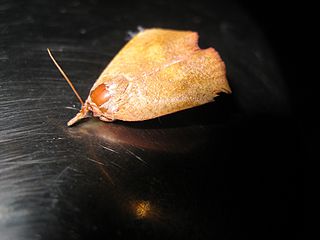Agathiphaga is a genus of moths, known as kauri moths. and is the only living genus in the family Agathiphagidae. This caddisfly-like lineage of primitive moths was first reported by Lionel Jack Dumbleton in 1952, as a new genus of Micropterigidae.

Sematurinae is a subfamily of moths in the family Sematuridae represented by at least 29 species in the Neotropics.
Afrophyla is a monotypic moth genus in the family Geometridae described by Warren in 1895. Its only species, Afrophyla vethi, was first described by Snellen in 1886. It is found in eastern Africa.

Blepharoctenucha is a monotypic moth genus in the family Geometridae described by Warren in 1895. Its only species, Blepharoctenucha virescens, first described by Arthur Gardiner Butler in 1880, is known from India and Taiwan.
Celonoptera is a monotypic moth genus in the family Geometridae. Its only species, Celonoptera mirificaria, is found in south-eastern Europe. Both the genus and species were first described by Julius Lederer in 1862.
Ithysia is a monotypic moth genus in the family Geometridae. Its only species is Ithysia pravata. The genus was erected by Jacob Hübner in 1825, but the species had been first described by Hübner in 1813.

Agrotis amphora is a species of moth of the family Noctuidae. It is found in Kashmir.
Sorocaba is a monotypic moth genus of the family Phiditiidae. Its only species, Sorocaba anomala, is found in São Paulo, Brazil. Both the species and genus were described by Frederic Moore in 1882.

Hyblaea constellata is a moth in the family Hyblaeidae first described by Achille Guenée in 1852. It is found in India, Sri Lanka, south-east Asia, including China, Japan, Taiwan, Myanmar and Thailand. It is also found in Queensland, Australia.

Hyblaea ibidias is a moth in the family Hyblaeidae. It is found in New South Wales, Australia.

Snellenia is a genus of moths in the family Stathmopodidae.
Leucotmemis sanguinea is a moth of the subfamily Arctiinae. It was described by Max Gaede in 1926. It is found in Peru.

The genus Mania comprises a group of tropical and semi-tropical New World moths in the family Sematuridae. The genus has historically been referred to as either Nothus or Sematura, but both of these names are invalid.
Somabrachys infuscata is a species of moth in the family Somabrachyidae. It was described by Johann Christoph Friedrich Klug in 1830.
Hyblaea dilatata is a moth in the family Hyblaeidae described by Max Gaede in 1917.
Hyblaea inferna is a moth in the family Hyblaeidae described by Max Gaede in 1917.
Hyblaea insulsa is a moth in the family Hyblaeidae described by Max Gaede in 1917.
Hyblaea rosacea is a moth in the family Hyblaeidae described by Max Gaede in 1917.
Hyblaea strigulata is a moth in the family Hyblaeidae described by Max Gaede in 1917.




